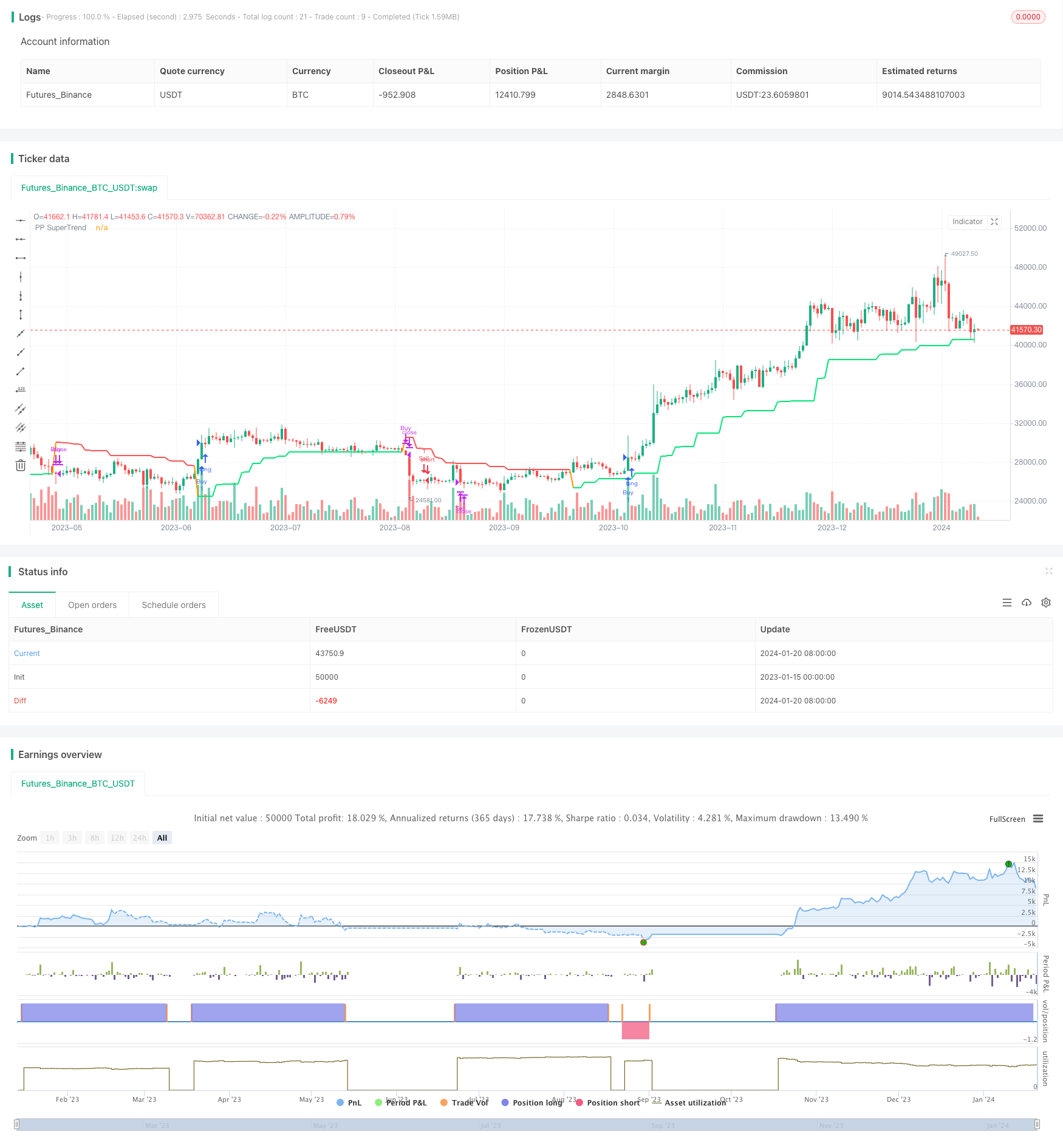
概述
该策略结合超趋势指标(Super Trend)、枢轴点(Pivot Points)和平均真实波幅(Average True Range, ATR)形成的动态止损线,以及平均方向指数(Average Directional Movement Index, ADX)指标,实现对趋势的判断和跟踪。策略适合短线交易,可以捕捉中间盘整理后的趋势延续部分,回撤控制也做得不错。
策略原理
超趋势指标结合枢轴点和ATR止损,判断价格突破动态止损线的方向来决定建仓方向。同时,ADX指标判断趋势力度,仅在趋势足够强劲时才发出交易信号。
具体来说,枢轴点先得到最新的支撑阻力,然后与前两日算术平均形成动态中间价。接着计算ATR并乘以ATR因子,再与动态中间价相加减,得到上轨和下轨。当价格突破上轨时看涨,突破下轨时看跌。ADX指标则判断趋势的力度,只有在趋势足够强劲时才参与交易。
止损线会根据最新价格和ATR值进行动态调整,能够很好地跟踪趋势。
优势分析
该策略具有以下优势:
利用超趋势指标跟踪趋势运行方向,避免被震荡市锁定利润。
借助ADX指标判断趋势力度,避免在盘整时造成错误交易。
止损线动态调整,最大程度锁定利润。
结合RSI避免过买过卖。
整体来说,策略参数设定合理,在dframe选取上考虑了连续性,止盈止损设置也不错。
风险分析
该策略也存在一些风险:
超趋势指标和MA指标可能发出冲突信号。
ADX指标设定为14周期,对突发事件敏感度不足。
RSI参数设置为默认值,可能无法完全避免过买过卖。
未考虑突发事件的影响,如重大利空/利好新闻。
对应解决方法:
调整MA周期,使其与超趋势指标匹配。
尝试缩短ADX周期,增加对突发事件的敏感度。
优化RSI参数,寻找最佳值。
加入新闻过滤模块,避开重大新闻发布。
优化方向
该策略还可以从以下几个方面进行优化:
增加机器学习模型判断趋势,使交易决策更加智能。
尝试引入情绪指标等替代ADX指标判断趋势力度。
增加自适应止损模块,让止损更加动态和精确。
借助深度学习技术提取更多特征,优化整体策略。
利用高级语言如Python进行策略开发,增加策略的扩展性。
总结
本策略整体来说非常实用,核心就是跟踪趋势运行方向,并在趋势足够强劲时参与。止损和止盈设置也做得很到位,最大程度锁定利润而避免亏损扩大。当然,仍有很大的优化空间,如果增加机器学习和深度学习技术,会使策略效果更出色,也更具有拓展性和通用性。
/*backtest
start: 2023-01-15 00:00:00
end: 2024-01-21 00:00:00
period: 1d
basePeriod: 1h
exchanges: [{"eid":"Futures_Binance","currency":"BTC_USDT"}]
*/
//@version=5
strategy("Bendre ADX STrend", overlay = true)
///////////////////////////
// SuperTrend + Pivot Point
//////////////////////////
src = input(close, title="EMA Source")
PPprd = input(defval = 2, title="Pivot Point Period")
AtrFactor=input(defval = 2, title = "ATR Factor")
AtrPd=input(defval = 21, title = "ATR Period")
StartDate = input(timestamp("1 Dec 2023"), title="Start Date")
EndDate = input(timestamp("12 Jan 2024"), title="End Date")
window() => true
var float ph = na
var float pl = na
ph := ta.pivothigh(PPprd, PPprd)
pl :=ta.pivotlow(PPprd, PPprd)
float center = na
center := center[1]
// float lastpp = ph ? ph : pl ? pl : 0.0
float lastpp = na(ph) ? na(pl) ? na : pl : ph
if lastpp > 0
if na(center)
center := lastpp
else
center := (center * 2 + lastpp) / 3
Up = center - (AtrFactor * ta.atr(AtrPd))
Dn = center + (AtrFactor * ta.atr(AtrPd))
var float TUp = na
var float TDown = na
Trend = 0
TUp := close[1] > TUp[1] ? math.max(Up, TUp[1]) : Up
TDown := close[1] < TDown[1] ? math.min(Dn, TDown[1]) : Dn
Trend := close > TDown[1] ? 1: close < TUp[1]? -1: nz(Trend[1], 1)
Trailingsl = Trend == 1 ? TUp : TDown
// Lines
linecolor = Trend == 1 and nz(Trend[1]) == 1 ? color.lime : Trend == -1 and nz(Trend[1]) == -1 ? color.red : na
plot(Trailingsl, color = linecolor , linewidth = 2, title = "PP SuperTrend")
bsignalSSPP = close > Trailingsl
ssignalSSPP = close < Trailingsl
///////
// ADX
//////
lenADX = 14
th = 14
TrueRange = math.max(math.max(high-low, math.abs(high-nz(close[1]))), math.abs(low-nz(close[1])))
DirectionalMovementPlus = high-nz(high[1]) > nz(low[1])-low ? math.max(high-nz(high[1]), 0): 0
DirectionalMovementMinus = nz(low[1])-low > high-nz(high[1]) ? math.max(nz(low[1])-low, 0): 0
SmoothedTrueRange = 0.0
SmoothedTrueRange := nz(SmoothedTrueRange[1]) - (nz(SmoothedTrueRange[1])/lenADX) + TrueRange
SmoothedDirectionalMovementPlus = 0.0
SmoothedDirectionalMovementPlus := nz(SmoothedDirectionalMovementPlus[1]) - (nz(SmoothedDirectionalMovementPlus[1])/lenADX) + DirectionalMovementPlus
SmoothedDirectionalMovementMinus = 0.0
SmoothedDirectionalMovementMinus := nz(SmoothedDirectionalMovementMinus[1]) - (nz(SmoothedDirectionalMovementMinus[1])/lenADX) + DirectionalMovementMinus
DIPlus = SmoothedDirectionalMovementPlus / SmoothedTrueRange * 100
DIMinus = SmoothedDirectionalMovementMinus / SmoothedTrueRange * 100
DX = math.abs(DIPlus-DIMinus) / (DIPlus+DIMinus)*100
ADX = ta.sma(DX, lenADX)
//////
// MA
/////
lenMA = 21
srcMA = input(close, title="Source")
// offsetMA = input(title="Offset", type=input.integer, defval=0, minval=-500, maxval=500)
offsetMA = input(0, title="Offset")
outMA = ta.sma(srcMA, lenMA)
//
// RSI
//
length = input( 14 )
overSold = input( 30 )
overBought = input( 65 )
price = close
vrsi = ta.rsi(price, length)
//
// DMI - Direction Movement Index
//
[diplus1, diminus1, adx] = ta.dmi(14, 14)
// Buy - Sell Entries
buy = bsignalSSPP and outMA < close and ADX > th
sell = ssignalSSPP
if (buy and vrsi > overBought and adx > 19)
// .order // Tuned version
strategy.entry("Buy", strategy.long, when = window())
// strategy.close("Sell", "close Sell")
if (sell) and (strategy.position_size > 0)
// strategy.entry("Sell", strategy.short)
strategy.close("Buy", "Close Buy")
if(sell and vrsi < overSold and adx > 25)
strategy.entry("Sell", strategy.short, when = window())
if ( ta.crossover( diminus1, diplus1) or ((buy) and (strategy.position_size > 0)) )
strategy.close("Sell", "close Sell")
// if(sell) and (diminus1 > diplus1) and adx > 23 and adx > adx[1] and (vrsi < overSold)
// strategy.entry("Sell", strategy.short, when = window())
// if (strategy.position_size > 0 and ta.crossunder(diminus1, adx)) or (strategy.position_size > 0 and (buy))
// strategy.close("Sell", "close Sell")